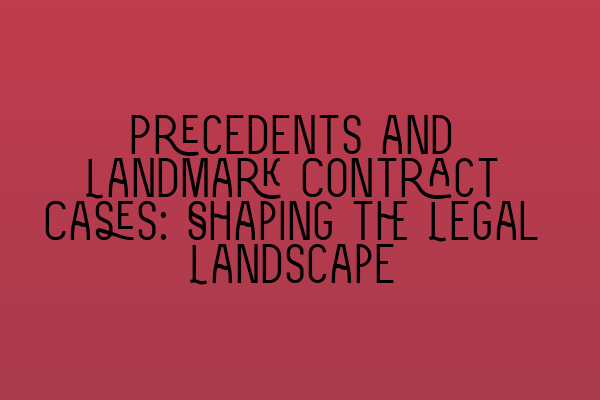Precedents and Landmark Contract Cases: Shaping the Legal Landscape
Introduction
Contract law is the backbone of modern commerce. It provides a framework for parties to establish legal relationships, define obligations, and enforce their rights. Over the years, numerous precedents and landmark contract cases have played a crucial role in shaping the legal landscape. In this blog post, we will explore some of these cases and the impact they have had on contract law.
1. Carlill v. Carbolic Smoke Ball Company (1893)
One of the most famous contract cases in history is Carlill v. Carbolic Smoke Ball Company. In this case, the court held that an offer made to the public can be binding if the offer is clear, definite, and contains the intention to be bound. The case established the principle that unilateral contracts can be formed by performance rather than the traditional acceptance.
2. Donoghue v. Stevenson (1932)
Donoghue v. Stevenson is a landmark case that laid the foundation for the modern law of negligence. In this case, the court established the principle of duty of care, which states that a person has a legal duty to take reasonable care to avoid acts or omissions that could reasonably be foreseen as likely to cause harm to others. This case had a profound impact on contract law by introducing the concept of negligence as a basis for liability.
3. The Moorcock (1889)
The Moorcock case is significant because it introduced the concept of implied terms into contract law. In this case, the court held that there is an implied term in contracts that requires both parties to act in good faith and carry out their obligations in a reasonable manner. This decision has had a lasting impact on the interpretation and enforcement of contracts, as it established the principle that parties must adhere to an implicit duty of good faith.
4. Hadley v. Baxendale (1854)
Hadley v. Baxendale is a landmark case that established the principle of foreseeability in contract law. The court held that a party can only be liable for damages that are reasonably foreseeable at the time the contract is made. This decision has had a significant impact on the assessment of damages in contract disputes and is still widely followed today.
Conclusion
Precedents and landmark contract cases have played a vital role in shaping the legal landscape. These cases have provided guidance on the interpretation and enforcement of contracts, introduced new concepts and principles, and established important precedents that continue to influence contract law today.
As legal professionals, it is essential to study and understand these cases to effectively represent clients and navigate the complexities of contract law. By staying up to date on the latest precedents and landmark cases, solicitors can provide the best possible legal advice and ensure that their clients’ interests are protected.
Related Articles:
– SQE 1 Practice Exam Questions
– SQE 1 Practice Mocks FLK1 FLK2
– SQE 2 Preparation Courses
– SQE 1 Preparation Courses
– SRA SQE Exam Dates
